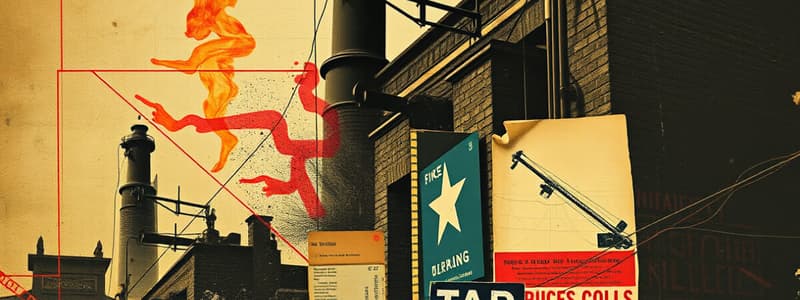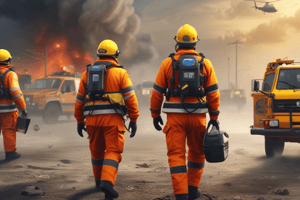Podcast
Questions and Answers
What characteristic of cold smoke poses a danger during fire incidents?
What characteristic of cold smoke poses a danger during fire incidents?
- It dissipates quickly in open areas.
- It flows rapidly with high turbulence.
- It can be present with or without active fire suppression. (correct)
- It is always a sign of minimal fire activity.
In large-space buildings, what construction method primarily increases the risk of early structural collapse during a fire?
In large-space buildings, what construction method primarily increases the risk of early structural collapse during a fire?
- Presence of truss construction. (correct)
- Implementation of fire-rated enclosures.
- Installation of smoke control systems.
- Use of lightweight wood framing.
What should be assumed if there is partial roof collapse in a large-space building?
What should be assumed if there is partial roof collapse in a large-space building?
- The fire sprinkler system remains unaffected.
- The area is safe for entry and operations.
- The fire sprinkler system has likely been compromised. (correct)
- The substantial water supply is still available.
What significant hazard is associated with warehouses that store rolled paper?
What significant hazard is associated with warehouses that store rolled paper?
When assessing smoke presence during size-up, what must be considered about the smoke flow?
When assessing smoke presence during size-up, what must be considered about the smoke flow?
Which factor can influence the weight and risk of material collapse in a fire incident?
Which factor can influence the weight and risk of material collapse in a fire incident?
What is a potential challenge for roof operations in large-space buildings?
What is a potential challenge for roof operations in large-space buildings?
Which aspect relates to hazard assessment in fire risk management for large-space buildings?
Which aspect relates to hazard assessment in fire risk management for large-space buildings?
What factor regarding material storage in large-space buildings significantly affects the potential for collapse during a fire incident?
What factor regarding material storage in large-space buildings significantly affects the potential for collapse during a fire incident?
In the context of fire safety, how does cold smoke primarily differ from other types of smoke?
In the context of fire safety, how does cold smoke primarily differ from other types of smoke?
Which factor could imply a significant incident requiring a heightened response in large-space buildings?
Which factor could imply a significant incident requiring a heightened response in large-space buildings?
What construction feature in large-space buildings can contribute to an increased risk of early structural collapse?
What construction feature in large-space buildings can contribute to an increased risk of early structural collapse?
Why should partial roof collapse in a large-space building raise concerns about the fire sprinkler system's integrity?
Why should partial roof collapse in a large-space building raise concerns about the fire sprinkler system's integrity?
Which method is recommended for facilitating ventilation in large-space buildings during a fire incident?
Which method is recommended for facilitating ventilation in large-space buildings during a fire incident?
What is a critical hazard associated specifically with warehouses that store rolled paper?
What is a critical hazard associated specifically with warehouses that store rolled paper?
The presence of which factors increases the complexity of fire fighting operations in large-space buildings?
The presence of which factors increases the complexity of fire fighting operations in large-space buildings?
Flashcards are hidden until you start studying
Study Notes
Fire Sprinkler Systems
- Over a century of successful history in protecting life and property from fire.
- Civilian fire fatalities in buildings with sprinkler systems are extremely rare.
Risk Management Focus
- Actions prioritize property protection when no people are trapped.
- Risk management strategies must align with property protection goals.
Challenges in Large-Space Buildings
- Firefighter challenges include dealing with cold smoke, which flows calmly and is extremely dangerous.
- Presence of cold smoke during initial assessment is significant, indicating potential fire.
- Small amounts of smoke can indicate a substantial fire in large-space buildings.
Fire Dynamics
- Storage configurations (height and type) affect fire behavior; materials can become heavier when wet and may cause collapses.
- Construction features, such as building size and fire-rated enclosures, influence fire containment.
- Large open spaces typically use truss construction, increasing risk of early structural collapse if fire spreads.
Structural and Incident Response
- Partial roof collapses indicate probable compromise of the fire sprinkler system.
- A significant fire incident often requires a first alarm response or greater.
- Presence of hazardous materials necessitates careful monitoring and assessment.
Fire Protection and Ventilation
- Importance of assessing fire detection and protection systems available.
- Ventilation methods include roof vents, skylights, doors, and exhaust systems to manage smoke and heat.
- Ensure adequate water supply for firefighting efforts.
Specific Hazards
- Warehouses storing rolled paper pose a significant fire hazard.
- Historical incident in 1978 where a fire in a paper storage warehouse resulted in the deaths of three Canadian firefighters due to unstable paper rolls during overhaul.
Defensive Operations
- If the fire sprinkler system fails to control a fire, it will escalate rapidly.
- Fire control may require defensive operations, including exterior suppression via master streams, particularly outside of the collapse zone.
Fire Sprinkler Systems
- Over a century of successful history in protecting life and property from fire.
- Civilian fire fatalities in buildings with sprinkler systems are extremely rare.
Risk Management Focus
- Actions prioritize property protection when no people are trapped.
- Risk management strategies must align with property protection goals.
Challenges in Large-Space Buildings
- Firefighter challenges include dealing with cold smoke, which flows calmly and is extremely dangerous.
- Presence of cold smoke during initial assessment is significant, indicating potential fire.
- Small amounts of smoke can indicate a substantial fire in large-space buildings.
Fire Dynamics
- Storage configurations (height and type) affect fire behavior; materials can become heavier when wet and may cause collapses.
- Construction features, such as building size and fire-rated enclosures, influence fire containment.
- Large open spaces typically use truss construction, increasing risk of early structural collapse if fire spreads.
Structural and Incident Response
- Partial roof collapses indicate probable compromise of the fire sprinkler system.
- A significant fire incident often requires a first alarm response or greater.
- Presence of hazardous materials necessitates careful monitoring and assessment.
Fire Protection and Ventilation
- Importance of assessing fire detection and protection systems available.
- Ventilation methods include roof vents, skylights, doors, and exhaust systems to manage smoke and heat.
- Ensure adequate water supply for firefighting efforts.
Specific Hazards
- Warehouses storing rolled paper pose a significant fire hazard.
- Historical incident in 1978 where a fire in a paper storage warehouse resulted in the deaths of three Canadian firefighters due to unstable paper rolls during overhaul.
Defensive Operations
- If the fire sprinkler system fails to control a fire, it will escalate rapidly.
- Fire control may require defensive operations, including exterior suppression via master streams, particularly outside of the collapse zone.
Studying That Suits You
Use AI to generate personalized quizzes and flashcards to suit your learning preferences.




